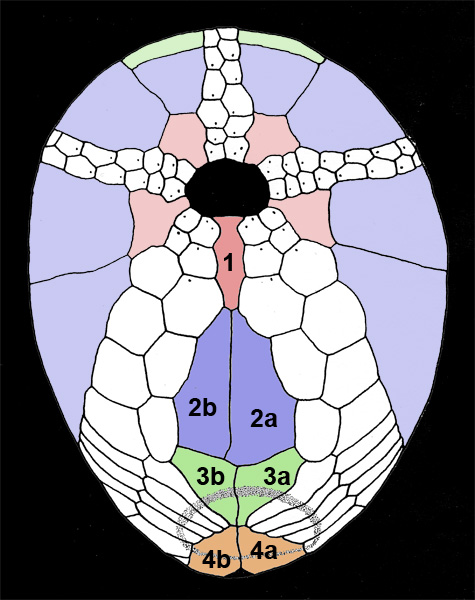Glossary
Glossary terms beginning with: S
show all images
- scraper
-
An internal flange that originated from the basicoronal plate in interambulacrum 3 and is associated with supporting the pharynx in atelostomates. Picture shows the inside of a broken test in oblique view.
(show image)
- scrobicular spines
-
Specialized flattened spines that form a protective pallisade around the base of primary spines and cover their muscle ring.
(show image)
- scrobicular tubercle
-
A small tubercle immediately surrounding the primary tubercle and bearing a specialized flattened spine that protects the muscle of the adjacent primary spine.
(show image)
- scrobicule
-
A ring of differentiated small tubercles surrounding the primary tubercle and bearing specialized flattened spines that protect the muscle of the adjacent primary spine.
(show image)
- secondary spine
-
A spine attached to mamelonate tubercles on ambulacral or interambulacral plates which flank the primary spine and tubercle.
- secondary tubercle
-
A smaller tubercle flanking the primary tubercle.
(show image)
- semicompound plate
-
A compound ambulacral plate composed of three elements of which only two are united by an overlying tubercle: the third element is simple. This is also known as acrosaleniid plate compounding.
(show image)
- semiethmolytic (disc)
-
A compact apical disc in which genital plate 2 is extended posteriorly between the posterior genital (G1, G4) but not between the posterior ocular (OI, OV) plates.
(show image)
- shaft
-
The part of a spine that lies distal to the basal attachment
(show image)
- simple (ambulacral plate)
-
An ambulacral plate that corresponds to a single element. Each succesive plate bears its own primary tubercle in a column.
(show image)
- spatulate (spine)
-
A spine with a shaft that ends distally in an expanded and flattened tip.
(show image)
- sphaeridial pit
-
A pit on ambulacral plates in which the sphaeridium sits. These may be perradial or positioned close to the ambulacral pores and are usually developed only on plates close to the peristome.
(show image)
- sphaeridium (-a)
-
A microscopic, highly modified glandiform spine used for sensing body orientation. Sphaeridia are present in all but the cidaroids and are mostly confined to the adoral region of ambulacra. Oral area of a spatangoid shown with basicoronal plates in blue
(show image)
- spine
-
An articulated appendage used for defence or locomotion.
(show image)
- stereom
-
The term applied to the microstructure of the plate, in which calcite is deposited as an interconnected meshwork of rods.
(show image)
- sternal plates
-
Plates 2a and 2b (purple) in the posterior interambulacrum of atelostomate echinoids . These are the first pair of plates following the labral plate (red) and are often enlarged to form much of the posterior oral surface. These plates usually bear locomotory spines.

- subanal (fasciole)
-
An ovate, bilobed or shield-shaped fasciole near the base of the posterior face beneath the periproct.
(show image)
- subanal heel
-
A projecting region at the base of the posterior face beneath the periproct.
(show image)
- subanal tube feet/pores
-
Specialized tube-feet/pores arising from the inner columns of ambulacral plates at the angle between the oral and posterior face. These are present only in Atelostomata and used for building a sanitary funnel in burrowing urchins.
(show image)
- sucker (tube-foot)
-
The distal disc of a tube-foot, supported by a rosette of plates and used for adhesion. The phtograph shows the tube feet suckers clearly, attached to a glass plate.
(show image)
- sulcus (ambulacral)
-
A concave ambulacrum forming a furrow over the test. Usually refers to the anterior ambulacrum in spatangoids and holasteroids.
(show image)
- suranal plate
-
An enlarged periproctal plate. In saleniids the suranal plate(s) form an integral part of the apical disc. In Echinoida they are present only in early development.
(show image)
- sutural pits
-
Deep pits usually positioned at the junction of three plate sutures on the exterior of the test (arrowed). Their function is unknown.
(show image)
- suture
-
The boundary between two adjacent abutting plates of the test.
(show image)
|